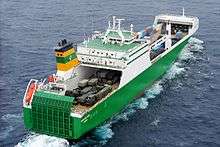Point-class sealift ship
 MV Longstone | |
| Class overview | |
|---|---|
| Name: | Point class |
| Builders: |
|
| Operators: | Foreland Shipping Ltd (formerly AWSR Ltd) |
| In service: | 2002–current |
| Completed: | 6 |
| Active: | 4 under contract with the MoD |
| General characteristics | |
| Type: | Roll-on/roll-off |
| Displacement: | 23,000 tonnes full load[1] |
| Length: | 193.0 m (633.2 ft)[1] |
| Beam: | 26.0 m (85.3 ft)[1] |
| Draught: | 7.6 m (25 ft)[1] |
| Propulsion: |
|
| Speed: | 21.5 knots (39.8 km/h) |
| Range: | 9,200 nautical miles (17,000 km) at 21.5 knots (39.8 km/h) |
| Capacity: |
|
| Crew: | 18-22 |
| Sensors and processing systems: | I-band navigation radar |
| Armament: | None |
| Aviation facilities: | Can carry up to four helicopters including Chinnok, Merlin and Lynx |
| Notes: | Sourced from Jane's Fighting Ships 2008–2009, p. 876 |
The Point class is a class of six roll-on/roll-off sealift ships originally procured under a Private Finance Initiative to be available for use as naval auxiliaries to the British armed forces. Two of the ships have now been released from the contract, leaving four available for service with the military.
Background
The Point-class sealift ships are the result of the Strategic Defence Review and are designed by Houlder Ltd for the strategic transport of military cargoes and vehicles in times of need. The UK Ministry of Defence has purchased a 22-year charter from Foreland Shipping (previously named "AWSR Shipping"), who own, operate and crew the ships, utilising them as merchantmen when they are not required for military service. The small British crews are provided by Foreland Shipping and are required to be sponsored reserves as a condition of service, which means they can be called up to become part of the Armed Forces in times of crisis. The benefits of this is that it guarantees crews in times of crisis, it means crew members can be expected to work under the Armed Forces Act 2006 rather than the Merchant Navy Code of Conduct, and that they would be classed as combatants and be afforded the rights granted under the Geneva Convention.

Of the six ships, MV Longstone and Beachy Head were on charter to the civilian company "Transfennica" operating a RoRo cargo ferry service in the Baltic Sea, connecting Hanko in Finland and Lübeck in Germany. Most recently they have been operating on the Immingham to Cuxhaven route for DFDS. Other ships have also been involved in commercial activity with other companies and other militaries. All ships are available to the UK MOD at very short notice if required. The first four ships have been kept almost constantly busy on MoD duties since the build-up to the Iraq invasion in 2003, but MV Longstone and Beachy Head have seen little MoD service and in the current budget environment are likely to be sold.
Four ships were built by the German company Flensburger Schiffbau-Gesellschaft, the balance being built by Harland and Wolff in Belfast. All are named for British points and headlands. They replaced the Royal Fleet Auxiliaries RFA Sea Centurion and Sea Crusader in service.
Operational history
MV Hartland Point was part of the COUGAR 12 Response Force Task Group and also active in operations off the Cornish coast in 2012.[2][3] MV Hurst Point made a port call at Gibraltar in August 2013 and is part of the COUGAR 13 Response Force Task Group.[4][5] Hartland Point recently worked with the Royal Navy and French Navy on Operation Corsica Lion 2015.[6] MV Hurst Point has been used to replenish the Falkland Islands garrison.[7]
PFI status
According to a Defence Select Committee report, "Four of the Ro-Ro ships are permanently contracted to the MoD with the other two at notice for MoD tasking. For the two ships at notice, one can be accessed in 20 days and the other in 30 days."[8]
In the Autumn of 2011, it was stated that the two ships at short notice would be released from the PFI, leaving four ships available for use by the MoD.[9] The ships released were the MV Beachy Head and the MV Longstone, and the RMT union was informed that these vessels would be laid up or sold.[10]
Ships in the class
| Name | Builder | Commissioned |
|---|---|---|
| MV Hurst Point | Flensburger Schiffbau[11] | 16 August 2002[11] |
| MV Hartland Point | Harland & Wolff, Belfast[11] | 11 December 2002[11] |
| MV Eddystone | Flensburger Schiffbau[11] | 28 November 2002[11] |
| MV Anvil Point | Harland & Wolff, Belfast[11] | 17 January 2003[11] |
| MV Longstone (no longer available to the MoD) | Flensburger Schiffbau[11] | 24 April 2003[11] |
| MV Beachy Head (no longer available to the MoD) | Flensburger Schiffbau[11] | 17 April 2003[11] |
See also
References
- 1 2 3 4 The Royal Navy Handbook, 2003, Ministry of Defence, page 104
- ↑ http://www.royalnavy.mod.uk/sitecore/content/home/news-and-events/latest-news/2012/october/08/121008-cougar-exercise-cornwall
- ↑ http://www.royalnavy.mod.uk/sitecore/content/home/news-and-events/latest-news/2012/september/27/120921-cougar-preview
- ↑ http://www.seawaves.com/portvisits.asp
- ↑ "Navy: Military Exercises: 5 Sep 2013: Hansard Written Answers - TheyWorkForYou". theyworkforyou.com. Retrieved 9 August 2016.
- ↑ "Corsican evacuation tests Anglo-French Task Group - Royal Navy". mod.uk. Retrieved 9 August 2016.
- ↑ johnt (15 February 2016). "Everything You Need To Know About British Forces In The Falklands". forces.tv. Retrieved 9 August 2016.
- ↑ http://www.publications.parliament.uk/pa/cm200607/cmselect/cmdfence/462/462.pdf
- ↑ "Shipping: 6 Nov 2013: Hansard Written Answers - TheyWorkForYou". theyworkforyou.com. Retrieved 9 August 2016.
- ↑ Todd, Steve. "Shipping News". RMT News July/August 2013. p. 26. Retrieved 2 June 2014.
- 1 2 3 4 5 6 7 8 9 10 11 12 Jane's Fighting Ships, 2004–2005. Jane's Information Group Limited. p. 819. ISBN 0-7106-2623-1.
External links
| Wikimedia Commons has media related to Sealift ships. |
- United Kingdom Strategic Sealift (Roll-On Roll-Off Vessels) (globalsecurity.org)